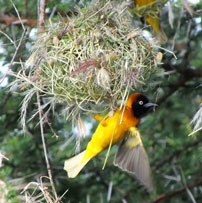 Every time I go to Africa I fall a little bit further under its spell; the endless landscapes, the people and of course the big game, but with each visit I also become more and more enamored with the birdlife. The flashes of luminescent colour in the dry bush or the melodious calls which have me searching for a bird tucked away in lush vegetation have me enthralled and enchanted in equal measure.
Every time I go to Africa I fall a little bit further under its spell; the endless landscapes, the people and of course the big game, but with each visit I also become more and more enamored with the birdlife. The flashes of luminescent colour in the dry bush or the melodious calls which have me searching for a bird tucked away in lush vegetation have me enthralled and enchanted in equal measure.
Kenya’s rich diversity of habitats makes it a haven for bird watchers throughout the year and my recent trip reinforced that.
 The weather in mid-March was capricious to say the least. Our landing at Amboseli was a little exciting as the wind suddenly whipped up creating a storm of mini dust devils all around but almost as soon as we disembarked the wind was replaced by rain. This later gave way to that lovely late afternoon sunshine, and sunshine and showers was definitely the pattern for the remainder of the trip.
The weather in mid-March was capricious to say the least. Our landing at Amboseli was a little exciting as the wind suddenly whipped up creating a storm of mini dust devils all around but almost as soon as we disembarked the wind was replaced by rain. This later gave way to that lovely late afternoon sunshine, and sunshine and showers was definitely the pattern for the remainder of the trip.
Amboseli National Park is perhaps best known for its views of towering Mt. Kilimanjaro and for the elephant population brought so regularly into our living rooms via the many documentaries, often featuring Cynthia Moss and her longstanding research. However the birdlife is also abundant with over 400 recorded species found mainly close to the swamps, fed by underground rivers from Kilimanjaro and by the seasonal Lake Amboseli.
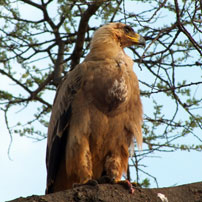 As we drove north to the neighbouring Selenkay Conservancy it wasn’t the mammals that caught our attention, but rather the incessant chatter and songs of the birds as they emerged from whatever shelter they had found during the rain storm. Luminescent superb starlings were ubiquitous, raptors such as the long crested eagle, tawny and brown-snake eagle patrolled high above, and Wilson, our excellent guide from Porini Selenkay Camp was over the moon to spot a golden pipit. What delayed us most however were the industrious lesser masked weavers and we watched for some time as the males worked hard at building a nest that they hoped would match the expectations of any prospective mate. Competition was fierce and we saw several attempts at sabotage and even blatant theft as they jostled for the best building materials.
As we drove north to the neighbouring Selenkay Conservancy it wasn’t the mammals that caught our attention, but rather the incessant chatter and songs of the birds as they emerged from whatever shelter they had found during the rain storm. Luminescent superb starlings were ubiquitous, raptors such as the long crested eagle, tawny and brown-snake eagle patrolled high above, and Wilson, our excellent guide from Porini Selenkay Camp was over the moon to spot a golden pipit. What delayed us most however were the industrious lesser masked weavers and we watched for some time as the males worked hard at building a nest that they hoped would match the expectations of any prospective mate. Competition was fierce and we saw several attempts at sabotage and even blatant theft as they jostled for the best building materials.
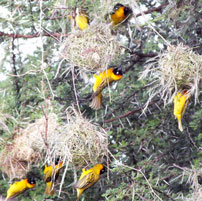 The fantastic birding is not limited to the plains however; at Tortilis Camp the trees overhanging the tents are laden with nests whose occupants herald each new dawn and the lush gardens of Tawi Lodge are also a magnet for huge numbers of avian visitors.
The fantastic birding is not limited to the plains however; at Tortilis Camp the trees overhanging the tents are laden with nests whose occupants herald each new dawn and the lush gardens of Tawi Lodge are also a magnet for huge numbers of avian visitors.
Next stop was Meru National Park, without doubt one of Kenya’s most overlooked parks. Meru suffered terribly from poaching in the 1980’s, but today the game is thriving with an excellent elephant population, healthy numbers of lion and leopard, albeit a bit shy, and a well-established rhino sanctuary. Birding too is exceptional and the dry scrubland provides the perfect backdrop. A pair of Verraux’s eagle owls resting in a tree and a glimpse of a golden breasted starling were highlights.
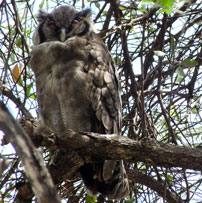 Whilst it is always exciting to spot one of the more scarcely seen species, sometimes it is just as rewarding to spend time watching the more everyday birds going about their daily routines; the herons preparing to roost in the late afternoon sunshine, voluminous and twittering flocks of red billed quileas, flitting from bush to bush and the stately saddle-billed storks wading through the waters and fishing for their supper.
Whilst it is always exciting to spot one of the more scarcely seen species, sometimes it is just as rewarding to spend time watching the more everyday birds going about their daily routines; the herons preparing to roost in the late afternoon sunshine, voluminous and twittering flocks of red billed quileas, flitting from bush to bush and the stately saddle-billed storks wading through the waters and fishing for their supper.
Having travelled through the stunning Laikipia wilderness and spending a glorious day walking with Kerry Glen we continued to the Great Rift Valley lakes. I had been hopeful of seeing the famous flocks of lesser flamingoes, so identifiable with Lake Nakuru, but to no avail. Over recent years the water levels at the lakes have risen enormously, one reason being given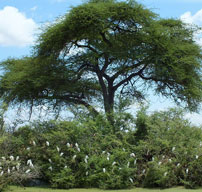 is a shift in the earths plates; indeed some of the roads I remembered travelling along on previous visits, are now firmly under water and new roads have been put in. The resultant change in the alkaline levels of the water have led to a decrease in algae and hence in the food supply for the enormous population of flamingoes who have moved to lakes Bogoria and Oloidien. It is not all bad news however as the remaining 450 species of birds, have flourished and the reduction of available grassland means that the resident mammal population; rhino, lions, baboons, waterbuck to name but a few, are significantly more visible.
is a shift in the earths plates; indeed some of the roads I remembered travelling along on previous visits, are now firmly under water and new roads have been put in. The resultant change in the alkaline levels of the water have led to a decrease in algae and hence in the food supply for the enormous population of flamingoes who have moved to lakes Bogoria and Oloidien. It is not all bad news however as the remaining 450 species of birds, have flourished and the reduction of available grassland means that the resident mammal population; rhino, lions, baboons, waterbuck to name but a few, are significantly more visible.
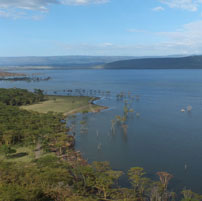 The birders amongst you will already know what a fantastic birding destination Kenya is, but if you haven’t yet been seduced by the colours and the sounds of avian life, do take the time to look, it really is quite magical!
The birders amongst you will already know what a fantastic birding destination Kenya is, but if you haven’t yet been seduced by the colours and the sounds of avian life, do take the time to look, it really is quite magical!
